
1. Gold continues to flow from the West to the East at a pretty solid pace.
2. To view the latest evidence of this fact, please click here now. The SPDR fund (GLD-NYSE) holdings have oozed down to just 809 tonnes…and done so while the price of gold has strengthened!
3. Many Western countries are net exporters of gold in quantities that exceed their total mine production.
4. Please click here now. Double-click to enlarge this gold chart.
5. Gold’s latest rally began from the July 10 area lows of about $1205. The SPDR fund holdings were about 839 tonnes at that time. Gold’s $50 rally over the past two weeks has occurred while the SPDR fund holdings have fallen noticeably.
6. The powerful commercial traders that operate on the COMEX follow the physical market meticulously. The SPDR fund is the Western fear trade’s physical market “crown jewel.” Flows into it influenced the gold price substantially during the 2009 – 2011 time frame. Quantitative easing was the fundamental theme in play.
7. The fact that gold can rally now while SPDR fund holdings tumble suggests that Chindian love trade buying is overwhelming Western fear trade selling in the price discovery process.
8. From both a fundamental and technical perspective, this rally is now due for a pause. Technically, an inverse H&S bottom pattern appears to be forming. A pause now in the neckline area at about $1260 would allow the right shoulder of this pattern to form.
9. Fundamentally, the next Fed meeting is tomorrow and gold tends to trade softly around Fed events. I’ve recommended light profit booking into this rally and I continue to do so.
10. Please click here now. Double-click to enlarge this important US dollar versus Japanese yen chart.
11. The dollar has fallen against the yen and fallen against gold since July 10. In the short term, a pause for gold and a rally for the dollar seems imminent.
12. In the bigger picture, the dollar could begin a “meltdown” phase as gold bursts above the neckline in the $1260 area. A move above $1260 opens the door to a surge towards $1300, which is a bigger profit booking area for gold investors.
13. Please click here now. Double-click to enlarge. GDX had a particularly nasty day yesterday. It broke down from a negative wedge pattern on heavy volume.
14. To understand what happened, please click here now. Acacia is majority owned by Barrick, and Barrick is a major GDX component stock.
15. While Acacia could theoretically recover from this nightmare, it looks hopeless. Even if they do convince the Tanzanian government to reduce the tax bill, that could take years. The sand in Acacia’s hourglass is running out fast.
16. Gold stocks are likely to stumble more than gold in the short term because of this Acacia quagmire. There is some very good “big picture” news though.
17. To view it, please click here now. I’ve been a little disappointed with the slow pace of the Trump administration in making its campaign promises happen.
18. Having said that, Trump’s appointment of Randy Quarles to the Fed may be a much more positive event than most analysts realize. It could be his most important action since taking office.
19. That’s because it may represent the beginning of the end for the bank bonus system that has benefitted Wall Street at the expense of Main Street.
20. The bottom line is that Dodd-Frank regulation has combined with low interest rates to create a small business loans quagmire. Thousands of small American banks aren’t engaged in trading with other people’s money like the big banks are. They get all the regulatory stick, and none of the trading with other people’s money carrot!
21. Quarles could make significant progress in ending this hideous quagmire by reducing regulations. That opens the door to ending the 22 year down cycle in money velocity.
22. The arrival of Quarles at the Fed with a deregulatory mandate is not a “free gold stocks parabola now” buy signal, but it is a key step in an important process that can reward patient gold stock investors. It’s very difficult for gold stocks to consistently outperform gold bullion while US money velocity is in a bear cycle.
23. I’ve dubbed Randy Quarles “Mr. America”. That’s because he can be the catalyst that ends the bear cycle in bank loans, money velocity, and gold stocks versus gold. A few more rate hikes from Janet combined with real deregulation of the US banking system can produce a powerful bull cycle in bank loans to Main Street.
24. It would come at the expense of Wall Street. I’ve predicted that if Quarles is successful, Main Street can grow America’s GDP at a 5% rate, while the US stock market goes into a stagflationary gulag. The entire world gold community should cheer that Quarles makes the US banking system, Main Street, and gold stocks… great!

In October last year, Callinex Mines Inc., a zinc and copper miner operating in established mining jurisdictions in Manitoba, Canada, announced some exciting news relating to their exploration efforts – the company had discovered a zone of high-grade zinc at 13.1% zinc equivalent at its Pine Bay project in Flin Flon.
Since that discovery, Callinex has ambitiously pushed forward its exploration efforts with expanding drilling campaigns at its zinc project in Pine Bay, as well as its Nash Creek and Superjack projects in the Bathurst mining district.
Directed by a knowledge-rich team that includes Mike Muzylowski, Callinex is led by CEO and President and Director Max Porterfield, who has more than ten years of experience in natural resources and financial markets, including time with Brazil Resources Inc., Uranium Energy Corp. and working with Frank Holmes at US Global Investors.
Max Porterfield spoke to us about his industry background, the outlook for the Canadian mining industry, Callinex and his vision for the future.
MiningFeeds: Thank you very much for taking the time to speak with us.
Max Porterfield: It’s my pleasure.
MiningFeeds: First off, can you run down briefly for our readers your history in mining prior to leading Callinex and what led you to take on your current role at the company?
Max Porterfield: I spent five and a half years working at US Global Investors, which is headed up by Frank Holmes down in San Antonio, Texas. There, I was primarily involved in institutional sales and raising capital for the funds that were managed by the company. US Global Investors is a boutique investment firm that specializes in natural resources and precious metals investing. So, naturally, they were interested in investing in junior exploration companies like Callinex.
My real takeaways at US Global was having the opportunity to work closely with the portfolio managers and, from a fund management standpoint, how they looked at making investments in the space and what kind of companies met their investment criteria.
After leaving US Global, I spent two years working with Uranium Energy Corp and at what’s now Gold Mining Inc. managing investor relations on the corporate side of the business. Thereafter, the opportunity at Callinex came along and I haven’t looked back since then.
One of the reasons why I joined Callinex was to have the opportunity to work with a legendary geologists and businessman in Mike Muzylowski, who’s been a mentor to me helped bring me up to speed on the exploration side of the business. Additionally, Callinex’s project portfolio was strategically located near Flin Flon, MB, which is a world class jurisdiction with an excellent pedigree.
MiningFeeds: Can you tell us what the status of operations is for Callinex in Manitoba? And what has been the most significant development so far in Callinex’s exploration efforts?
Max Porterfield: Without a doubt the most significant development for the Company in Manitoba has been at the Pine Bay project in Flin Flon. In October of last year, the Company intersected 10.3 meters at 13.1% zinc equivalent. Being that the drill hole intersected the mineralization in a geologic environment where Placer Dome had previously held a 30mt exploration target certainly got us and the market very excited. We plan to complete additional follow-up drilling which will commence in August. We will also be conducting exploration on our newly acquired Big Island project which hosts a high grade zinc deposit that has not been followed up in the modern era.
MiningFeeds: What’s the timeline of your drilling campaign in August?
Max Porterfield: It will begin in mid-August and is planned for 5,000m of drilling which may be upsized based on exploration results.
MiningFeeds: On a leadership level, what are your expectations for Callinex? And what are you looking for in the coming year?
Max Porterfield: Aside from our operations in Flin Flon, we are currently conducting an aggressive exploration campaign at two recently acquired projects in the Bathurst Mining District of New Brunswick. The Nash Creek and Superjack projects each host zinc-rich VMS deposits that are located within trucking distance to active processing facilities. The focus on exploration at our projects in the Bathurst Mining District is to expand the size of the deposits at time when supply/demand fundamentals favor higher zinc prices in the near future. I am optimistic that the Company will have exploration success across the project portfolio in Flin Flon and Bathurst in a rising zinc price environment.
MiningFeeds: What are your expectations for the zinc markets over the next year or two years? What do you think are going to be the largest or most significant factors for the zinc and copper markets?
Max Porterfield: Zinc, which is the primary metal we are exposed to, has rallied to near its 52-week high and has been a top performer across all commodities over the past year. With that being said, the fundamentals are still there for much further gains due to constrains on global supply. Above ground inventories have been eroded over the past several years to levels not seen since the last bull run the commodity had in 2006. Additionally, a significant portion of mine supply has come off line as large zinc mines have come to their end of life but there has been very little exploration or development of new zinc mines during this time. Additionally, treatment charges by smelters have been coming down also signaling that the smelters are having trouble locating new zinc concentrates to refine.
The big demand for zinc is when its used in the galvanization process. The big megatrend that’s driving consumption of the metal is the global infrastructure build out. Continued infrastructure spending in the coming years from emerging economies such as China and the re-building of infrastructure in developed economies such as the United States will have a large impact on sustained zinc demand.
MiningFeeds: Can you give any more specific thoughts on how the Trump administration may factor in to demand over the next several years?
Max Porterfield: I believe the policies he’s putting in place could stimulate demand for base metals. The headline number for the administrations infrastructure plan has been $1t. More recently its been outlined that $200 billion will be federally funded over the next decade which would incentivize additional investments from state governments and the private sector. All this infrastructure — more bridges, roads — it’s all going to a massive amount of metals.
MiningFeeds: Is there anything specific, any big takeaways you’d like readers to know?
Max Porterfield: We are well capitalized for exploration and development of our project portfolio. Our technical team has been credited with three of the four largest discoveries in the Flin Flon Mining District’s history, that’s actively exploring two of the most prolific and well known established VMS districts globally. Our shareholders are also poised to benefit from higher zinc prices because of the nature of the deposits we are advancing in our portfolio.
MiningFeeds: Thank you very much for your time.

1. Over the past week or so, gold and associated assets have rallied quite nicely.
2. Please click here now. Double-click to enlarge this daily gold chart.
3. The $1237 price area is a good place to book partial profits on positions bought in my $1220 – $1200 buy zone.
4. Gold feels quite solid here. The five and ten day moving averages have turned up. The 14,7,7 Stochastics oscillator is also flashing a buy signal and moving higher.
5. Please click here now. The latest COT report was also very positive.
6. While the rally can continue, smart investors book profit systematically into strength and good news. So, I’m adamant that some profit should be booked here. Gold has rallied more than $30 from the $1205 area low.
7. If the rally accelerates, the wise investor books even more profit. If it stalls, investors should get a chance to buy again at lower prices… using some of the market’s money rather than theirs!
8. Gold stocks are not likely to reverse their multi-decade bear cycle against bullion until US money velocity stages a new bull run, but they still outperform bullion on rallies.
9. My focus in the precious metals market in 2017 has been GDX and individual gold stocks, mainly to prepare for that bullish reversal in money velocity. The reversal should produce a multi-decade cycle of gold stock outperformance against bullion.
10. Please click here now. Double-click to enlarge this interesting GDX chart.
11. I’ve been an aggressive buyer of GDX into the recent $21 area lows, and partial profits definitely need to be booked now. This chart shows that GDX is bumping up against a significant supply-side trendline.
12. If the price moves back below $21, that capital can be re-deployed into GDX even more aggressively. I’m a buyer on every ten cents decline, and a partial seller on 50 cents rallies from my buy points.
13. This isn’t so much “trading” as it is pruning. As they grow, lawns must be mowed and hedges must be pruned. As the price of GDX increases, some profit must also be pruned. Investors can use my pyramid generator to do that systematically.
14. Regardless, core positions in the precious metal sector need to be held with an iron fist. Just as a gardener mows their lawn rather than ripping the whole lawn out by the roots, the gold market investor needs to hold large core positions to take advantage of what I call the “gold bull era”.
15. Please click here now. That’s a snapshot of recent Indian gold imports, courtesy of Nick Laird.
16. I’ve stated that the 2013 – 2016 slowdown in these imports should be viewed as a temporary issue.
17. The imports slowdown created the swoon in gold from $1500 to $1100 and the bigger swoon in mining stocks. The good news is that the swoon is over.
18. As Chindian citizens get more wealth, they buy phones, cars, and other gadgets. They also buy more gold. Unlike phones and cars, it’s very hard to increase the supply of gold. The bull era will be created by an ongoing failure of gold supply to meet the exponential demand growth from Chindian citizens.
19. The price of gold will be driven relentlessly higher from this process not just in terms of price, but in terms of time. Empires tend to peak after about 200 years.
20. The relentless rise of the Chinese and Indian gold-oriented empires should move the gold price consistently higher for the next 100 – 200 years.
21. The West is in decline, and the decline could become a stagflationary nightmare. For wealth building purposes, I would suggest that the world gold community should view the decline of the West as very thick icing on a bull era cake.
22. Please click here now. Double-click to enlarge this exciting bitcoin chart.
23. I’ve labelled blockchain currencies as the newest and hottest sector of the precious metals family of assets. Bitcoin gained about $450 just in the past 24 hours, surging from about $1850 to $2300! I cover the action at www.gublockchain.com Wealth building enthusiasts can be bitcoin buyers on every $100 or $200 price dip, and “prune the blockchain tree” on rallies of $200 – $400. I’m pruning mine right now!
24. As the price of rises more aggressively due to finite supply (my long term price target is $500,000usd), Chinese and Indian bitcoin investors will likely book a lot of profit and use that profit to buy lots of gold. It’s a win-win situation for the entire global precious metals community.

One of the primary keys to success in investment and speculation is picking the right stocks to trade. That’s no mean feat, as it takes great effort, expertise, and time to winnow the whole field down to the likely winners with the best fundamentals. Although deeply out of favor now in the summer doldrums, the small contrarian gold-stock sector has generated truly epic gains for investors and speculators over the years.
I’ve been in the financial-newsletter business for 17 years now, after founding my company Zeal LLC way back in early 2000. I needed to do extensive markets and individual-stocks research to support my own personal speculation and investment, so I figured why not share it so others can benefit as well. Since then I’ve researched and written 765 web essays, 204 monthly newsletters, and 748 weekly newsletters.
The primary mission of my research has always been to drive profitable real-world trading. If financial-market research doesn’t actually help multiply wealth, why even bother? The stock trades resulting from these 17 years of hard work were all recommended in real-time in our newsletters as the buys and sells were actually made. Our cumulative realized stock-trade count is now up to 357 in our monthly and 571 in our weekly.
928 real-world stock trades fully disclosed to, fully accountable to, and fully auditable by our subscribers over such a long span of time has been an unparalleled learning experience. Like all speculators we won some and lost some, but our overall track record is outstanding. All 928 Zeal newsletter stock trades ever closed, including all losers, have averaged impressive annualized realized gains of +22.0% since 2001!
Since our first newsletter was published on August 1st, 2000, the compound annual rate of return of the benchmark S&P 500 has only been 3.1%. The S&P 500’s absolute return over that long intervening secular span is 67.6%. But 22.0% compounded annually since then equates to a radically-better 2903.4% return. There’s no doubt that studied stock picking and trade timing can vastly outperform the indexes!
Since general stocks have mostly been mired in a secular bear since early 2000, the great majority of our Zeal trades have been gold stocks and silver stocks. The precious metals are one of the best-performing sectors during sideways-grinding general stock markets. So one of the most common questions I get is how do I go about picking great gold stocks? What factors do I consider in trying to sort the best from the chaff?
These are tough questions to answer. So much time on task, so many trades, so much experience both winning huge profits and suffering vexing losing streaks are challenging to distill down into a book, let alone an essay. It’s hard to even know where to start after tens of thousands of hours of research on markets and individual stocks. Nevertheless, I get this question so often that I should at least attempt to address it.
So here’s a brief overview of key things I look at when comparing and contrasting gold stocks attempting to find fundamentally-superior ones to trade. And “gold stocks” used in this essay applies equally to silver stocks. My stock-picking methodology is a perpetual work in progress. I’m always learning and striving to improve it, and there are plenty of traders out there with long track records better than mine.
Major-ETF Inclusion. Ask any prospector where the best place to find gold is, and he’ll say where it has already been found! Great gold stocks are very similar. So one of the first things I check when I’m researching individual stocks is what ETFs they are included in. The companies creating the leading exchange-traded funds and the indexes behind them have big research departments full of experienced analysts.
The dominant leading gold-miner, gold-junior, and silver-miner ETFs today are GDX, GDXJ, and SIL. They are the VanEck Vectors Gold Miners ETF, the VanEck Vectors Junior Gold Miners ETF, and the Global X Silver Miners ETF. Being considered worthy of inclusion in these elite ETFs truly is the gold standard in precious-metals stocks. So if a miner or explorer is large enough, I always check for ETF inclusion.
I certainly don’t only trade gold stocks included in major ETFs, but when one is I know it has been vetted by leading expert researchers. While some of the stocks they include perplex me, the majority are truly the best in the business. ETF inclusion can be a self-fulfilling prophecy too. Since most investors and speculators settle with ETFs these days instead of individual stocks, their ETF buying drives up components’ prices.
Market Capitalization. If I had to decide on a single-most-important factor for picking great gold stocks, I’d actually choose market capitalization. That may sound shocking, as how could market cap be even more important than production, costs, or reserves? The reason is market caps ultimately distill everything that all traders collectively know about any gold stocks, and govern their potential for big near-future gains.
When buying a house, the first thing you have to consider is price. It makes no sense to fall in love with a perfect house you simply can’t afford. Gold stocks’ market capitalizations, especially when they are considered relative to each other, give great insights into how valuable their mines and projects actually are. Market caps are the ultimate form of relative ranking resulting from actual real buy-sell votes from all traders!
When two gold miners with similar production levels have significantly-different market caps, the one with the higher market-assigned value almost always has the superior fundamentals. Investigating why market-cap differences of similar producers have arisen is one of the more-rewarding parts of gold-stock picking. Market-cap premiums often reveal superior mines, projects, or managements than similar peers have.
Market capitalizations also greatly affect future gains. The higher the market cap of any stock, the more capital inflows and buying will be necessary to drive it significantly higher. Like oil supertankers, the larger gold stocks have big market-cap inertia and will ultimately see smaller gains than their smaller peers. On the other end of this spectrum, super-tiny gold stocks will often prove too illiquid and risky to trade.
When comparing all gold stocks by market cap, there is a sweet spot of small-but-not-tiny to mid-size gold miners that have the best potential to see the greatest gains in their stock prices assuming their fundamentals are sound. The higher market caps among this optimal gold-miner size usually have the most-superior fundamentals, but the lower-market-capped stocks will be easier for new buying to push higher.
Jurisdiction and Diversification. Unfortunately mining companies are exceptionally vulnerable to local government over-regulation, over-taxation, and even confiscation. Unlike most industries, gold mines’ production can’t be shifted across borders to flee to more-friendly countries. So I always look to see where gold stocks’ mining operations and major exploration projects are located. Some countries are too risky for me.
Mexico and Canada are probably the best countries in the world to mine gold in. Their mining laws are well-established and their governments generally don’t harass miners too much. The US is safe, but over-regulation and ludicrously-onerous permitting processes make America somewhat less attractive. Plenty of countries in South America, Asia, and even Africa are fine, but property rights and rule of law are less certain.
But some countries often ruled by Marxist dictators have ugly histories of forcing gold miners into paying punitive taxes and royalties under the implicit threat of mine seizures. Like much of stock picking, that knowledge simply comes from experience. We’ve owned gold miners in the past that have suffered major predation by local governments, so it makes no sense to buy other miners with heavy exposure to them.
This great geopolitical risk inherent in static gold mining can be diversified through mines and projects spread across multiple jurisdictions. Smaller gold stocks only have one mine or project, so diversification is impossible. But larger ones have multiple mines and projects reducing the threat posed by any one government. Cross-country diversification does add significant costs as well though, it can be a double-edged sword.
Production. Gold stocks are naturally in the business of mining gold, so their current and projected production levels from mine expansions or new mines coming online are exceedingly important. The more gold companies produce, the greater their operating cash flows, profits, and therefore ultimately stock-price gains. But with larger operations also come bigger market caps, weighing down upside potential.
Within that sweet spot of smaller-to-mid-size gold miners, I like to compare miners’ production relative to their market caps. While this ratio means little in isolation, considered across a group of miners it helps reveal which are relatively expensive or cheap. As long as those miners with lower market caps per ounce produced have sound fundamentals, they often have greater upside potential than their more-popular peers.
Production trends are also important to consider. If a gold miner’s production is moderating or retreating for anything beyond a well-telegraphed few-quarter span, it suggests depleting mines and lower coming stock prices. Sometimes gold miners have good reason for lower production, such as planned digging through lower-grade ore to get to higher-grade ore or temporary disruptions due to mine-expansion projects.
Growing production is viewed highly favorably by traders and portends higher stock prices, so miners with consistent output growth are prized. Managements often provide guidance early every year for their coming annual production, making it easy to find expected growth. Big growth surges driven by new mines coming online are often great opportunities to see fast stock-price appreciation around their openings.
Since it’s far easier to simply consider reported current-quarter production instead of wading through quarterly filings, annual reports, and news releases to get updates on new mines nearing production, many investors overlook new-mine openings. Gold stocks often see major gains in the year or so that straddles new mines spinning up to commercial production, from about 3 quarters before to 1 quarter after.
A high-potential subset of this phenomenon occurs when explorers successfully manage to make that rare transition from explorer to producer. Since gold deposits now take 10 to 15 years to prove out, permit, and construct mines, most traders lose interest long before these plans come to fruition. So finding an explorer on the verge of opening its first mine in the next year or so can be a major upside opportunity.
Costs. Gold miners naturally have no control over the price of gold, their selling price is set by the whims of global gold traders. And gold-mining cash flows and profitability are totally determined by the difference between prevailing gold prices and miners’ costs. So gold miners’ cost levels are the critical driver along with the gold price of their operating cash flows and earnings. Costs drive profits leverage to gold.
Comparing gold miners’ costs, especially all-in sustaining costs, helps determine the better ones to buy. And that isn’t as simple as low costs are good and high costs are bad. Lower costs are great if gold is expected to go lower, as it makes for fundamentally-stronger miners generating more cash flow and thus better able to withstand gold corrections or bear markets. Low-cost miners are bid to premiums on weak gold.
While I prefer lower-cost miners since I like fundamentally-strong gold stocks, higher costs actually have greater upside profits leverage to gold-price increases! So if you expect a major gold bull or strong gold upleg, higher-cost miners actually have more upside potential. This seemingly-counterintuitive outcome is easy to understand with a simple example. Consider two hypothetical gold miners, LowCost and HighCost.
LowCost produces gold at AISC of $600 per ounce, so at $1200 gold it’s earning hefty operating profits of $600 per ounce. Meanwhile HighCost’s AISC are $1100, so its profits are far smaller at just $100. If gold powers 67% higher to $2000 in a major bull, LowCost’s profits more than double from $600 to $1400. But those 133% earnings gains are dwarfed by HighCost’s soaring from $100 to $900, a vast 800% rocketing!
Since stock prices ultimately reflect underlying corporate profits, higher-cost miners have much greater upside potential in a gold bull than their fundamentally-stronger lower-cost peers. Bigger profits growth equals bigger stock-price gains. So don’t avoid owning a gold stock simply because its costs are higher than its peers, as long as they’re still low enough to weather a major gold selloff. Costs are critical for profits.
Financials. Gold-mining costs directly feed another major factor to consider, gold miners’ financials. Cash flows generated from operations are important to analyze when picking great gold stocks. They are usually a better indication of gold miners’ fundamental strength than accounting earnings since the latter can be obscured by noncash writedowns or gains. Strong operating cash flows eventually drive strong profits.
I also always look at gold miners’ cash on hand, and debt levels and debt service. Just like with any individual, the more cash a gold miner has in the bank the easier it’s able to weather any unforeseen adverse shocks. They could be a gold selloff, a mine-production problem, or government harassment. Higher cash balances also position gold miners to expand existing mines or buy new deposits and mines.
While gold miners generally finance major mine builds with equity instead of debt, debt levels and quarterly payments relative to operating cash flows are also important to consider. While it’s rare to find gold miners with hefty debt payments compared to cash flows, I avoid them. Debt can point to another major potential problem, hedging. Banks often require gold miners to hedge production to secure a big loan.
Hedging, locking in the future selling price for gold produced, is highly undesirable. Investors buy gold stocks because they want leveraged upside exposure to gold-price advances, and hedging sells away that future upside! Hedging is a big black mark against a gold miner in my book, although I will still buy companies that hedge if their hedging is a small percentage of their production required for a mine-build loan.
Reserves. While gold reserves are important since they are necessary for gold miners to maintain their production, many investors overweight them. Proving up gold resources to reserves is very expensive, requiring big drilling and assaying campaigns. So as long as miners have sufficient reserves for the next couple years or so, it’s usually not beneficial to shareholders to spend capital to aggressively grow reserves.
Large reserves are more common in open-pit operations, where ore bodies are close to the surface and relatively easy to drill. Since the ore grades are so low in open-pit heap-leach mining, companies often market the value of their deposits in terms of their large reserves. But underground high-grade mines often only have a year or two of reported reserves because drilling too far ahead slows actual mining progress.
Dividing reserves by the current annual production gives an estimate of mine life. While more reserves granting a longer mining life make a company stronger fundamentally, they aren’t a major consideration for picking great gold stocks. In many ways the length of time gold miners have been producing, which shows their experience and longevity, is more important than showing off a massive reserves number.
Management. Managements’ track records are very important. Like in any industry, the longer that a management team has been running gold mines the more experience it has. And that eventually leads to success much of the time. So I consider what top managers have accomplished in the past, even if it was at another mining company. Proven battle-tested people are far more likely to produce excellent results!
For stock-price appreciation, managements’ ability to manage investors’ expectations conservatively is important. Management teams that consistently under-promise and over-deliver are far less likely to spook traders into selling en masse. So how managements perform on actual production and project advancement compared to the expectations they set in press releases is certainly worth considering.
Those press releases themselves also reveal much about how managements view and respect their shareholders. Great gold miners publish very-transparent quarterly results, full of numbers and year-over-year comparisons easy to parse visually. That builds trust. But I’ve seen far too many gold miners release quarterly results that are devoid of much important information. I always wonder if they’re hiding something.
While all companies naturally try to present their news and operating results in the best-possible light, deep data is always available from their quarterly filings with government regulators. So obscuring it through fact-light or poorly-presented news releases might fool a casual investor, but it won’t stop a real analyst from finding the truth in 10-Qs or 10-Ks. Managements being opaque can be a major warning sign.
Market Timing and Technicals. No matter how great gold miners’ fundamentals happen to be, they are all dependent on gold to see major stock-price moves. It’s relatively rare to see even great gold stocks power higher if gold strength isn’t lending them a bid. After all my years trading this sector, I suspect something way up around 80% of gold stocks’ price behavior is driven by the gold price action over any span analyzed!
While the fundamentally-superior gold miners will usually outperform in any given gold rally, they really do need gold to climb to enjoy major gains. So picking great gold stocks in a vacuum oblivious to the big market trends dominating their performance is an exercise in futility. While I’m constantly researching to understand individual gold stocks’ fundamentals, I try and wait to buy positions until gold is likely to advance.
Technicals are a critical consideration in picking great gold stocks too. Buying high is rarely wise no matter how awesome any gold miner may be. If a stock has just rallied dramatically, chances are it is due to mean revert and retreat a bit. But if a stock has just plunged, it is probably due for a big mean-reversion rebound. The best time to buy great gold stocks with superior fundamentals is right after they sell off!
When I make new trades, I usually narrow down my buy list to twice as many gold and silver stocks as I’m actually planning on buying. Since they all have great fundamentals after being sifted out of the gold-stock universe using the considerations above, I’ll often attempt to buy low by adding positions in the particular gold miners out of my finalists with the weakest technicals. Buying low is absolutely crucial!
Naturally that means gold-stock pullbacks and corrections driven by similar moves in gold are the best times to add gold stocks within ongoing bull markets. And the upside potential at those lows is dwarfed by that at major secular lows like January 2016’s. If you are buying gold stocks when they’re high and you’re excited, that’s the wrong time. The best time to buy is when they have just sold off and you are nervous!
Well, these are some basics of picking great gold stocks. I like to feed as many gold stocks as I can find into big spreadsheets, fill them with data on each company, and sort them based on all the things discussed here and other lesser considerations. Like any endeavor of learning, the more time you spend deeply immersed in gold stocks the better you will understand them and the easier it will become to pick the winners.
Realize that most investors and speculators simply don’t have the time, interest, training, necessary skillset, or temperament to put in the vast hours required to gain the knowledge and experience essential to excelling in trading any particular sector. So for most traders, it’s far more efficient to hire experts to do this hard work for them. The most-cost-effective way to benefit from expert analysis is through newsletters.
And it’s not just one thing that makes a great gold-stock pick, but the interplay of many things. Fitting all these puzzle pieces together to feed profitable trades is an art that only comes through years of actual real-world trading experience. If you have the time and mindset to develop this skillset, you’ll be richly rewarded by the markets. But if you don’t, piggybacking off the research from established experts is the way to go.

1. Most precious metal assets staged a solid “comeback rally” against government fiat yesterday.
2. Please click here now. Double-click to enlarge this key GDX chart. There’s decent intermediate trend technical support in the $21 area.
3. Hardcore accumulators can place buy orders for GDX in the $23 to $18 price zone.
4. To understand why this is a good idea, please click here now. The deep-pocketed commercial traders are serious gold buyers now.
5. They are likely anticipating the resumption of gold imports in India. Imports were halted at almost the exact intermediate trend high of $1300, partly because of uncertainly about the GST tax.
6. Commercial traders sold aggressively as gold approached $1300. Hedge funds bought, and gold gently swooned down towards support at $1200 where it sits now.
7. The commercial traders are now very aggressive buyers. The leveraged hedge funds are booking losses on long positions and adding short positions…into what is essentially a $100 gold price sale!
8. US coin sales are currently just a gold price discovery sideshow; there’s simply not enough physical market tonnage involved with these coin sales to cause the commercial traders to take serious buy or sell action on the COMEX.
9. Their focus was, is, and will be mainly on the changing flows of gold in the physical markets of China and India.
10. The commercial trader focus now suggests they are anticipating massive tonnage imports to begin again in India. Clearly, their aggressive COMEX buying is very good news for all gold bugs.
11. While US financial news isn’t that important for bullion price discovery, it’s very important for the gold and silver stocks.
12. Please click here now. Several years ago, I made the bold prediction that QE to infinity and rate cuts would become a taper to zero and rate hikes.
13. That occurred, and I have predicted that these hikes and what I call “QT to infinity” (quantitative tightening for many years) will create serious wage inflation and ultimately a major bull cycle in money velocity.
14. Gold stocks can “blow bullion to the curb” in this type of environment, and do so for years or even decades.
15. Top RBC bank analysts now have a similar view to mine about the prospects for the direction of US wage inflation. Up. Wage inflation is a major catalyst for institutional focus on gold stocks.
16. Rate hikes and QT can create wage inflation by moving huge amounts of liquidity away from government and central banks, and into the fractional reserve banking system.
17. This in turn is the catalyst for a reversal in US money velocity.
18. In regards to yesterday’s gold bullion price action specifically, please click here now. Yesterday’s launch of the new dual currency HKEX gold contract was successful.
19. It represents another slow but steady step forward by China to get more control of gold price discovery.
20. Please click here now. Chuck Li is chairman of the HKEX, Asia’s third biggest exchange. Chuck’s statement that Chinese demand is exponentially geared to economic growth is also the foundation of my prediction that a “bull era” is coming.
21. The exponential demand growth that lies ahead for China will itself ultimately be dwarfed by even bigger demand growth in India. These two gold-obsessed nations will function as a “bull era tag team”.
22. The bull era fun for gold stock investors will be magnified due to the rise of inflation in the West.
23. Please click here now. Double-click to enlarge this key BPGDM chart. I view the oversold and overbought areas for gold stocks a bit differently than most analysts do. That’s because gold stocks are so volatile.
24. The 60-100 area is a decent profit booking zone. The 20 – 0 zone is a good buying area and the BPGDM just arrived at the outskirts of that buying area now.

The gold miners’ stocks have drifted lower over the past month, slumping back to major support. This weakness has naturally intensified the bearish psychology engulfing this small contrarian sector, traders want nothing to do with it. Yet summers typically see gold and its miners’ stocks meander sideways to lower. These summer doldrums spawn the best seasonal buying opportunities of the year in gold stocks.
Seasonality is the tendency for prices to exhibit recurring patterns at certain times during the calendar year. While seasonality doesn’t drive price action, it quantifies annually-repeating behavior driven by sentiment, technicals, and fundamentals. We humans are creatures of habit and herd, which naturally colors our trading decisions. The calendar year’s passage affects the timing and intensity of buying and selling.
Gold exhibits high seasonality, which seems counterintuitive. Unlike grown commodities, the mined supply of gold is fairly constant year-round. But supply is only half of the fundamental supply-demand equation that drives pricing. Gold’s investment demand happens to be highly seasonal, and that’s what sets gold prices at the margin. Investors favor gold buying far more during some parts of the year than others.
This gold-demand seasonality is well-known and heavily studied. The seasonal gold year starts in late July as Asian farmers begin reaping their harvests. They plow some of their surplus income into gold. That’s followed by the famous Indian wedding season in autumn, with its heavy gold buying for brides’ dowries. That culture believes festival-season weddings have greater odds of yielding long, successful marriages.
After that comes the Western holiday season, where gold jewelry demand surges for Christmas gifts for wives, girlfriends, daughters, and mothers. Following year-end, Western investment demand balloons after bonuses and tax calculations as investors figure out how much surplus income the prior year generated for investment. Then Chinese New Year gold buying flares up after that heading into February.
These understandable cultural factors drive surges of outsized gold demand between late summer and early spring. There’s one more seasonal gold-demand spike in spring, where the causality is murkier. Spring’s increasing daylight and warmer temperatures breed optimism, which favorably affects investors’ sentiment. That leads to gold buying too among northern-hemisphere investors, the vast majority of the world’s.
While these major income-cycle and cultural factors fuel higher gold investment demand throughout the year, they disappear during market summers. June and July in particular are largely devoid of recurring seasonal gold buying. The markets take a back seat to vacations, with traders leaving their computers to bask in the glorious sunlight. So gold and its miners’ stocks, along with other markets, tend to drift listlessly.
A couple weeks ago I quantified this summer-doldrums phenomenon in depth for gold, silver, and their miners’ stocks. Summer has always been the weakest time of the year seasonally for the precious-metals sector. That naturally spawns widespread bearishness during market summers, which can really be challenging to weather psychologically. But it creates the best seasonal buying opportunity of the year!
The highest-probability-for-success time to aggressively deploy capital in gold stocks seasonally occurs in their typical mid-summer lull in July. That comes after the worst of the summer-doldrums downside in June, but before the Asian harvest buying gathers momentum in August. In the heart of summer, gold stocks are often shunned and therefore relatively cheap. That’s when contrarians seize the opportunity to buy low.
Quantifying gold’s seasonal tendencies during bull markets requires all relevant years’ price action to be recast in perfectly-comparable percentage terms. That’s accomplished by individually indexing each calendar year’s gold price to its final close of the preceding year. That’s set at 100 and then all the gold-price action of the following year is calculated off that common indexed baseline, normalizing all years.
So gold trading at an indexed level of 105 simply means it has rallied 5% from the prior year’s close, while 95 shows it’s down 5%. This methodology renders all bull-market-year gold performances in like terms. That’s critical since gold’s price range has been so vast, from $257 in April 2001 to $1894 in August 2011. That span encompassed gold’s last secular bull, which saw a colossal 638.2% gain over those 10.4 years!
So 2001 to 2011 were certainly bull years. 2012 was technically one too, despite gold suffering a major correction following that powerful bull run. At worst that year, gold fell 18.8% from its 2011 peak. That was not quite enough to enter formal bear territory at a 20% drop. But 2013 to 2015 were definitely brutal bear years, which need to be excluded since gold behaves very differently in bull and bear markets.
In early 2013 the Fed’s wildly-unprecedented open-ended QE3 campaign ramped to full speed, radically distorting the markets. Stock markets levitated on the Fed’s implied backstopping, slaughtering demand for alternative investments led by gold. In Q2’13 alone, gold plummeted by 22.8% which proved its worst quarter in an astounding 93 years! Gold’s bear continued until the Fed’s initial rate hike of this cycle in 2015.
The day after that first rate hike in 9.5 years in mid-December 2015, gold plunged to a major 6.1-year secular low. Then it started rallying sharply out of that irrational rate-hike scare, formally crossing the +20% new-bull threshold in early March 2016. Ever since, gold has remained in this young bull. At worst last December after gold was crushed on the post-election Trumphoria stock-market surge, it had merely corrected 17.3%.
So the bull-market years for gold in modern history ran from 2001 to 2012, skipped the intervening bear-market years of 2013 to 2015, and resumed in 2016 to 2017. Thus these are the years most relevant to understanding gold’s typical seasonal performance throughout the calendar year. We’re interested in bull-market seasonality, because gold remains in its young bull today and bear-market action is quite dissimilar.
This chart averages the individually-indexed full-year gold performances in those bull-market years from 2001 to 2012 and 2016. 2017 isn’t included in this analysis yet since it remains a work in progress. This chart distills out gold’s bull-market seasonal tendencies in like percentage terms. They reveal July is the best time seasonally to buy low. It’s near the end of summer weakness, before the parade of big seasonal rallies.
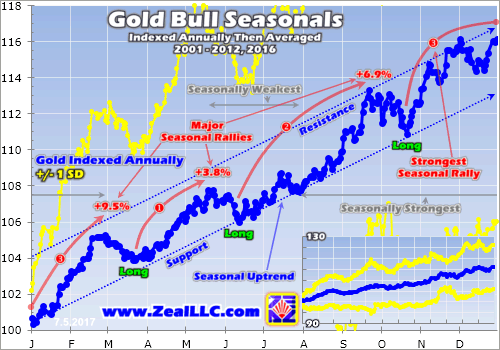
During these modern bull-market years, gold has enjoyed a strong and pronounced seasonal uptrend. From that prior-year-final-close 100 baseline, it has powered 16.2% higher on average by year-end! These are major gains by any standard, well worth investing for. While this chart is rendered in calendar-year terms since these increments are easiest for us to grasp, gold’s seasonal year actually starts in the summers.
Seasonally gold tends to bottom in mid-June, at 6.0% above the prior year’s final close. Remember this whole concept of seasonality relies on blending many years together, which smoothes away the outliers to reveal the core underlying tendency. This year gold actually surged into early June, and then slumped into early July. At its summer-to-date low of $1219 earlier this week, gold was up exactly 6.0% from 2016’s close!
Gold typically meanders in a summer trading range running +/-5% from May’s final close, as illustrated in my latest summer-doldrums essay. That runs from $1205 to $1332 this year. So despite gold’s rather-sharp selloff after its newest upleg peaked in early June, everything is perfectly normal so far based on the standards of past gold summers. Sentiment is bearish like usual, but there’s no need to fear or flee this sector.
Smart contrarian speculators and investors take advantage of these lackluster gold summers to buy big ahead of gold’s coming major autumn, winter, and spring rallies. While gold starts shaking off its summer malaise in July, the buying really accelerates in August and September. That’s when the Asians are buying aggressively, first after harvest and later for the Indian wedding season. This fuels a major autumn rally.
On average between mid-June to late September, gold has powered 6.9% higher in these modern bull-market years. That’s nothing to sneeze at. A similar rally this year off the early-July summer low would catapult gold back up to $1303. And a decisive $1300 breakout would greatly improve sentiment, which would unleash all kinds of technical buying. Now is the time to get deployed ahead of gold’s big autumn rally!
Gold then tends to suffer a sharp correction into late October, before its major winter seasonal rally gets underway. That runs from late October to late February, fueled first by Western holiday jewelry buying, then by Western income-surplus new-year buying, and finally by Chinese New Year. That happens to be gold’s best seasonal rally of the year by far, with gold powering 9.5% higher over that short span on average!
That October correction is so short and mild compared to gold’s bull-market seasonal rallies that it’s not worth worrying about in most years. So gold’s autumn and winter seasonal rallies can really be grouped into a single monster one, which runs from right about now to late winter. That’s why prudent contrarians have long loaded up on gold, silver, and their miners’ stocks deep in the heart of the summer doldrums.
After gold’s winter rally, there’s that last smaller spring one running from late March to late May. While it has only averaged 3.8% gains in modern bull-market years, that’s still nice icing on the cake after riding the preceding big autumn and winter rallies. All that gold rallying driven by outsized investment-demand spikes, nearly a year’s worth, starts from gold’s summer seasonal lull. Investors fleeing leave gold on sale.
And as goes gold, so go gold stocks. Gold stocks also exhibit strong seasonality, which is of course the direct result of gold’s own seasonality. Since gold-mining costs are largely fixed when mines are being planned, fluctuations in gold’s price flow directly into amplified moves in gold-mining profits. Higher gold prices drive much-higher earnings for the gold miners, which attract in more investors to bid up stock prices.
The ironclad historical relationship between the price of gold, gold-mining profitability, and therefore the gold-stock price levels is exceedingly important to understand. If you need to get up to speed, I wrote an essay looking at gold-stock price levels relative to gold a few months ago. Fundamentally gold stocks are leveraged plays on gold. Thus they really outperform during gold’s strong seasonal rallies throughout the year.
This next chart applies this same bull-market-seasonality methodology used on gold directly to the gold stocks. It looks at the average annual indexed performance in the flagship HUI NYSE Arca Gold BUGS Index in these same bull-market years of 2001 to 2012 and 2016. Because of gold’s dominant influence over gold-mining earnings, gold-stock seasonality naturally mirrors and amplifies gold’s own seasonality.
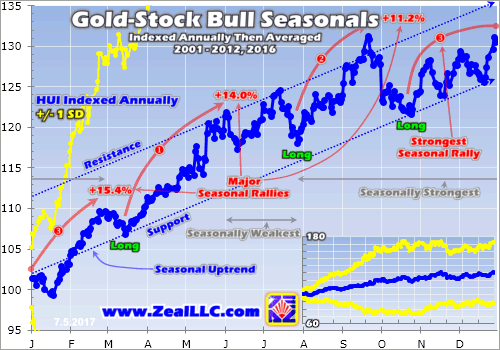
Gold stocks enjoy strong seasonal rallies corresponding with gold’s own. Yet unlike gold’s which vary considerably, gold stocks’ seasonal rallies have been much more consistent on average during these bull-market years. Starting in autumn, they ran 11.2%, 15.4%, and 14.0% compared to gold’s 6.9%, 9.5%, and 3.8%. The seasonal gains in gold stocks are more-evenly distributed over the calendar year than gold’s.
While 13 bull-market years are indexed and averaged in this chart, last year’s outsized gold-stock action still really influenced these seasonals. As measured by the benchmark HUI, gold stocks blasted 182.2% higher in just 6.5 months between mid-January and early August 2016! Later the post-election gold exodus on stock-market Trumphoria helped drive a massive 42.5% HUI drop by that brutal mid-December bottom.
So this entire gold-stock-bull seasonal chart shifted higher by about 5 indexed points compared to last year’s version before 2016! The gold stocks tend to bottom with gold seasonally, in mid-June. But that’s followed by a secondary low only slightly higher in late July. So on average, later this month is the best time of the year seasonally to throw heavily long gold stocks. They are battered down in the summer doldrums.
But remember these seasonals are based on bull-year average performances, they are mere tendencies not hard templates. So I’m not willing to roll the dice and wait until late July to deploy. Gold tends to rally modestly in July, up 0.8% on average in these bull-market years. And then its August gains accelerate to 2.1% on average. So gold stocks sometime rally in July with gold, making the June low a better time to buy.
A superior buy-low strategy than waiting for the seasonal-tendency average lows to come to pass is to seize the opportunity on any significant gold-stock weakness in June or July. That’s certainly the case this week, where the gold stocks slumped back to the same major support zone between 180 to 185 per the HUI from where they bounced in both early March and early May. That ought to prove this summer’s low.
While gold stocks are mired in universal bearishness in the summer doldrums, that’s the time to buy low ahead of their powerful autumn, winter, and spring rallies. It’s never easy fighting the herd to deploy into an out-of-favor sector, but that’s the only time stock prices are on sale. The opportunity to ride a parade of major 11.2%, 15.4%, and 14.0% seasonal rallies between now and next spring is unparalleled in all the markets.
Big gains aren’t unusual for this super-volatile sector that has long richly rewarded smart contrarians. In all of last year, the HUI still rocketed 64.0% higher trouncing every other sector despite all that brutal fourth-quarter selling. In gold stocks’ last secular bull between November 2000 and September 2011, the HUI skyrocketed 1664% higher over 10.8 years. That works out to huge 30%+ compound annual gains!
And since the gold stocks have way underperformed in the first half of 2017, odds heavily favor them mean reverting to far outperform in the second half. On average in these modern bull-market years, the HUI was up 17.3% year-to-date at its mid-June seasonal low. As of this week’s summer-to-date low, the HUI had actually slumped 0.4% since the end of last year! That’s why gold-stock sentiment is so hyper-bearish.
The major gold stocks of the HUI and also that leading GDX VanEck Vectors Gold Miners ETF generally see gains amplifying gold’s upside by 2x to 3x. Gold was once again up 6.0% year-to-date as of this week’s summer low. Thus in a normal year the HUI would’ve been up 12% to 18% in the first half, right in line with its bull-market-year seasonal averages. The tendency to mean revert is exceedingly strong in this sector.
Following periods when gold stocks really lag gold, they tend to see massive buying that catapults them back up to restore their normal fundamental relationship with the dominant driver of their profits. So the coming gold-stock upside in their autumn, winter, and spring seasonal rallies is likely to prove far larger than usual after such a weak first half of 2017. That makes this summer’s buying case exceptionally compelling.
Some of gold stocks’ biggest seasonal months of the year are right around the corner. This final chart breaks down gold-stock-bull seasonality as exhibited by the HUI into calendar months. Each is indexed to 100 as of the previous month’s final close, and then individual calendar months’ indexes are averaged across gold-stock-bull calendar years. These monthly seasonals flesh out the seasonal rallies’ internals.
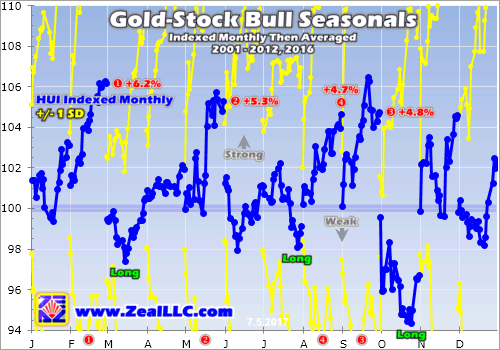
During these modern bull-market years from 2001 to 2012 and 2016, August and September were gold stocks’ fourth- and third-best months of the year seasonally! August averaged HUI gains of 4.7%, while September’s were even slightly better at 4.8%. While February and May are bigger, gold stocks have no other two-month span like August-September that averages such massive back-to-back gains for this sector.
That’s another reason why it’s so important to buy low in the summer doldrums when you least want to, when it feels miserable. Most speculators and investors aren’t contrarians, they haven’t painstakingly forged the hard discipline necessary to actually buy low. Instead they wait until after a sector has already rallied, and then chase the momentum. That’s not only far riskier, but yields much-lower long-term gains.
After gold stocks have already started powering higher in their coming big autumn rally, the easy gains have already been won. While there are outliers, the average of 13 years of bull-market gold-stock price action decisively proves that the summer doldrums are indeed the highest-probability-for-success buying opportunity of the entire year! Contrarians strong enough to fight the herd can back up the truck for great bargains.
I’ve studied and written about gold and gold-stock seasonality for many years now. And without a doubt the most-important thing to realize is seasonals are mere tendencies. While these averages over years are driven by underlying sentiment, technicals, and fundamentals, the seasonals can easily be overpowered in any year by these same driving forces. Seasonals are like tailwinds or headwinds, not primary engines.
So seasonal rallies are strongest when gold stocks have sentimental, technical, and fundamental reasons to power higher. That’s certainly the case this year. Bearishness in this sector is extreme after that terrible first-half performance, implying the sentiment pendulum is overdue to once again swing back to bullish. And after lagging gold so dramatically, gold-stock prices are likely to mean revert far higher to regain normalcy.
And relative to gold which drives their profits and thus ultimately stock prices, the gold miners’ stocks are exceedingly undervalued today. They have rarely been cheaper fundamentally. This will quickly become apparent when the gold miners report their Q2’17 results starting in late July. The average gold price climbed 3.1% to $1258 in Q2 from Q1, which should really boost this sector’s profits from already-strong Q1.
While investors and speculators alike can certainly play gold stocks’ coming autumn rally with the major ETFs like GDX, the best gains by far will be won in individual gold stocks with superior fundamentals. Their upside will trounce the ETFs’, which are burdened by over-diversification and underperforming gold stocks. A carefully-handpicked portfolio of elite gold and silver miners will generate much-greater wealth creation.
The bottom line is gold, and therefore its miners’ stocks, usually drift listlessly during market summers. As investors shift their focus from markets to vacations, capital flows wane. June and July in particular are simply devoid of the big recurring gold demand surges seen during much of the rest of the year, leaving them weak. While trying psychologically, that creates the year’s best seasonal buying opportunities.
These weak summer seasonals have existed for many decades at least, they should be expected. The summer doldrums need to be embraced, not feared. Traders fleeing drive gold-stock prices to some of their cheapest levels of the year relative to gold. So smart contrarians willing to fight the herd to deploy when it’s unpopular are subsequently richly rewarded when gold stocks’ seasonal rallies march much higher.

Intermarket analysis is a rather new field in technical analysis but one of my favorites because it is critical in understanding Gold. Asset classes like stocks and bonds are enormous and aren’t as influenced by as many factors as Gold. Trends in stocks, interest rates, commodities and currencies impact Gold in one way or another. We have written many articles over the years analyzing Gold with respect to its outlook and standing in real terms. Gold, when in a true bull market outperforms against all currencies and the global equity market. Unfortunately that is not the case at present. In real terms, Gold is weak, getting weaker and it could be a reflection of the metal’s worsening fundamentals.
In the first chart we plot Gold along with Gold against foreign currencies (FC) and Gold against stocks (inverse). While Gold (in nominal terms) has yet to break its 2017 uptrend, Gold/FC has and the Gold/Stocks ratio remains on the cusp of a major breakdown. Gold/FC has broken down from a mini head and shoulders top, lost its 200-day moving average and closed at a 6-month low. Meanwhile, the Stocks/Gold ratio is on the cusp of a breakout to a 2-year high. In short, Gold against both currencies and equities is weak and likely to get weaker.
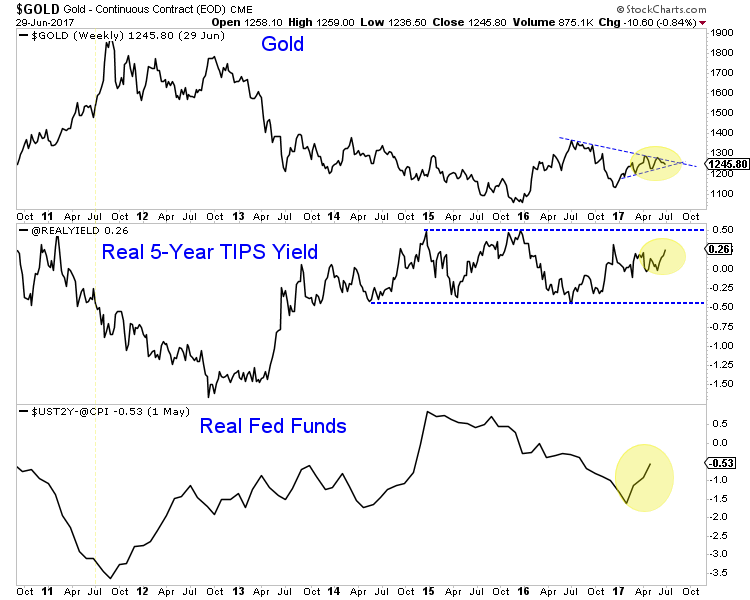
Gold’s weakness in real terms could be a reflection of its worsening fundamentals. As we’ve drilled into the head of readers, Gold is strongly inversely correlated to the trend in real interest rates. Negative and declining real interest rates push Gold higher while Gold struggles amid rising real interest rates.
Below we plot Gold along with the real 5-year yield (calculated from the TIPS market) and the real fed funds rate (using the 2-year yield as proxy). Inflation, which was rising until recently, is now declining. Interest rates declined since December 2016 but may have put in an important bottom in recent weeks. The result is an increase in real interest rates. Unfortunately, I see a good chance real rates continue to trend higher over the next several months.
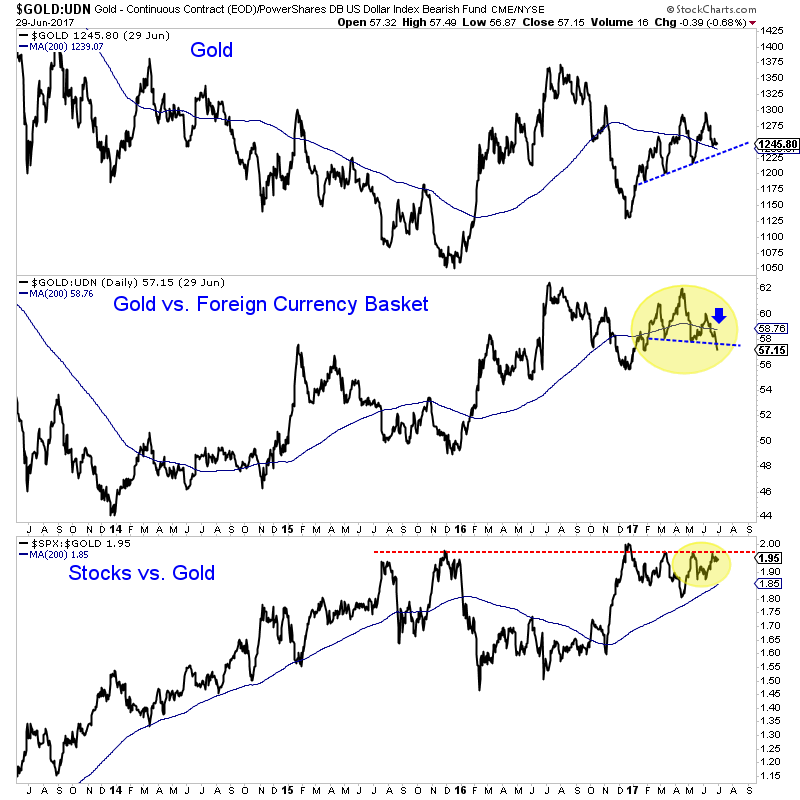
Until recently Gold had been holding up due to a weak US Dollar but Gold has become so weak in real terms that even that support is fading. This past week the US Dollar index plunged 1.6% but Gold lost 1.1% and gold stocks (GDX) lost 2.9%. The equity market declined four out of five days but even that failed to help precious metals catch a bid.
As you are probably well aware, the precious metals sector is approaching a breaking point and Gold’s weakness in real terms is another troubling sign. Moreover, Gold’s fundamentals are also warning of a break to the downside. While traders may have an opportunity on the short side, gold bugs and bulls should de-risk portfolios, handle their emotions and wait for the next true low risk buy opportunity.
If you would like to receive our free newsletter via email, simply enter your email address below & click subscribe.
CONNECT WITH US
Tweets
Tweet with hash tag #miningfeeds or @miningfeeds and your tweets will be displayed across this site.
MOST ACTIVE MINING STOCKS
Daily Gainers
 Lincoln Minerals Limited Lincoln Minerals Limited |
LML.AX | +125.00% |
      |
GCR.AX | +33.33% |
      |
CASA.V | +30.00% |
      |
AHN.AX | +22.22% |
      |
ADD.AX | +22.22% |
      |
AZM.V | +21.98% |
      |
NSE.V | +21.05% |
      |
DYG.V | +18.42% |
      |
AAZ.V | +18.18% |
      |
GLA.AX | +17.65% |


 Follow us on Twitter
Follow us on Twitter Become our facebook fan
Become our facebook fan








